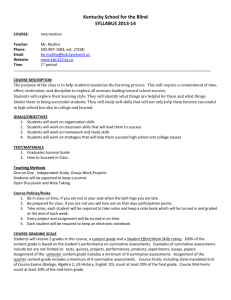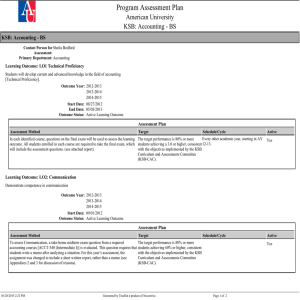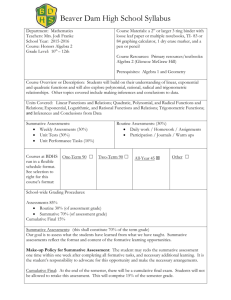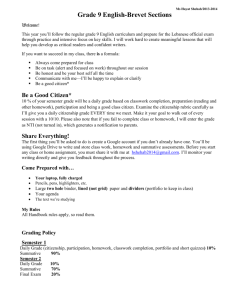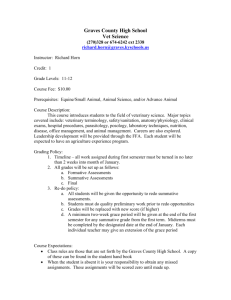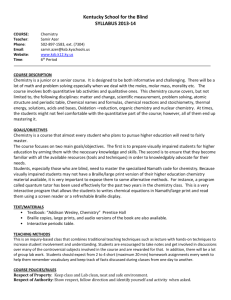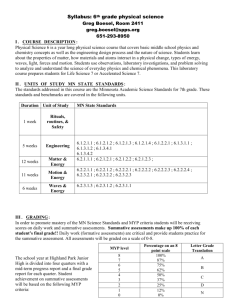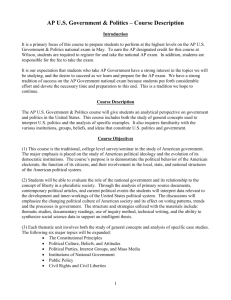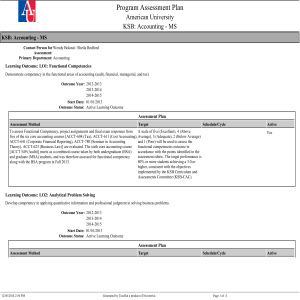Physical Science Syllabus 13-14
advertisement
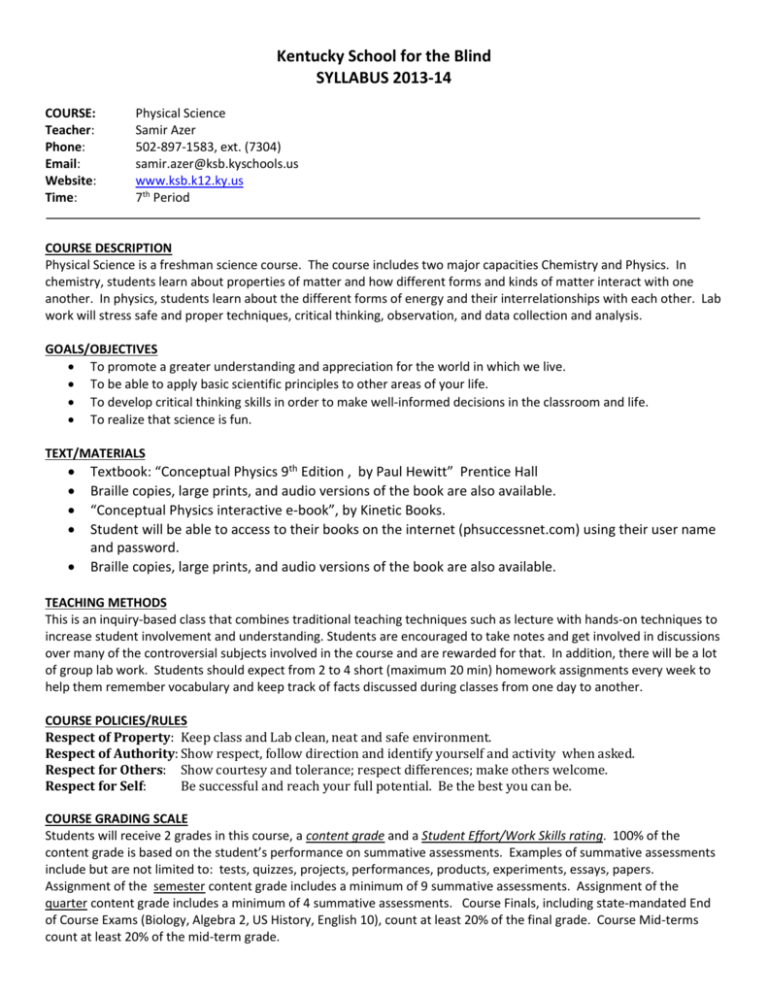
Kentucky School for the Blind SYLLABUS 2013-14 COURSE: Teacher: Phone: Email: Website: Time: Physical Science Samir Azer 502-897-1583, ext. (7304) samir.azer@ksb.kyschools.us www.ksb.k12.ky.us 7th Period COURSE DESCRIPTION Physical Science is a freshman science course. The course includes two major capacities Chemistry and Physics. In chemistry, students learn about properties of matter and how different forms and kinds of matter interact with one another. In physics, students learn about the different forms of energy and their interrelationships with each other. Lab work will stress safe and proper techniques, critical thinking, observation, and data collection and analysis. GOALS/OBJECTIVES To promote a greater understanding and appreciation for the world in which we live. To be able to apply basic scientific principles to other areas of your life. To develop critical thinking skills in order to make well-informed decisions in the classroom and life. To realize that science is fun. TEXT/MATERIALS Textbook: “Conceptual Physics 9th Edition , by Paul Hewitt” Prentice Hall Braille copies, large prints, and audio versions of the book are also available. “Conceptual Physics interactive e-book”, by Kinetic Books. Student will be able to access to their books on the internet (phsuccessnet.com) using their user name and password. Braille copies, large prints, and audio versions of the book are also available. TEACHING METHODS This is an inquiry-based class that combines traditional teaching techniques such as lecture with hands-on techniques to increase student involvement and understanding. Students are encouraged to take notes and get involved in discussions over many of the controversial subjects involved in the course and are rewarded for that. In addition, there will be a lot of group lab work. Students should expect from 2 to 4 short (maximum 20 min) homework assignments every week to help them remember vocabulary and keep track of facts discussed during classes from one day to another. COURSE POLICIES/RULES Respect of Property: Keep class and Lab clean, neat and safe environment. Respect of Authority: Show respect, follow direction and identify yourself and activity when asked. Respect for Others: Show courtesy and tolerance; respect differences; make others welcome. Respect for Self: Be successful and reach your full potential. Be the best you can be. COURSE GRADING SCALE Students will receive 2 grades in this course, a content grade and a Student Effort/Work Skills rating. 100% of the content grade is based on the student’s performance on summative assessments. Examples of summative assessments include but are not limited to: tests, quizzes, projects, performances, products, experiments, essays, papers. Assignment of the semester content grade includes a minimum of 9 summative assessments. Assignment of the quarter content grade includes a minimum of 4 summative assessments. Course Finals, including state-mandated End of Course Exams (Biology, Algebra 2, US History, English 10), count at least 20% of the final grade. Course Mid-terms count at least 20% of the mid-term grade. Grades are not reflective of student behavior and effort, homework, zeroes or reduced marks for late work, extra credit or bonus points, attendance*, academic dishonesty, or group work. The only exception may be for students participating in the regular or CBI work programs may have their grades impacted by attendance due to the performance-based nature of these work programs. Students will also receive a Student Effort/Work Skills (SEWS) rating . This rating demonstrates how the student performs in the following five areas: Self-Advocacy – uses assistive technology and/or other devices, establishes and monitors own goals, communicates wants and needs Initiative & Problem Solving – solves problems independently, addresses challenges, initiates own learning Interpersonal – adapts and transitions between tasks, demonstrates appropriate boundaries with others, displays age appropriate Work Habits – follows directions independently, utilizes an organization system, contributes to group work, uses time wisely Quality of Work/Homework – completes quality in-class work, completes quality homework Each of the above areas will be assigned a rating according to the following scale: 4 – Excellent 3 – Good 2 – Needs Improvement 1 – Unacceptable A Rubric for the SEWS grade will accompany the quarterly report card. If a student is struggling with grades, informal interventions will be developed with the classroom teacher. Students will receive an “Incomplete” before ever receiving an “F.” If a student receives an Incomplete, a Contract for an Incomplete Grade will be developed. There will be weekly quizzes except for some short weeks or when another summative assessment was given during this specific week. Chapter/Unit comprehensive tests will be conducted at the end of each chapter/Unit. Lab reports will be evaluated and graded. One or two projects will also be evaluated and graded. Students with the teacher supervision will produce rubrics for evaluating lab reports and projects. KSB GRADING SCALE A = 90-100 B = 80-89 C = 70-79 D = 60-69 I = Incomplete F = <60 ASSESSMENTS Diagnostic assessment: Students who newly joined the science class in KSB will be assessed prior to instruction to determine a student's attitude, aptitude, skills or knowledge in order to identify student’s needs. Formative assessment: Assessments designed to provide feed back to the teacher to allow him to adjust the program for individual students. This includes but not limited to exit slips and short after lesson evaluation handouts. Summative assessment: These are designed to evaluate students understanding for the curriculum taught and student achievement. The following are descriptions of the summative assessment students can expect in this class. Chapter/unit tests mostly include both multiple choice and open ended questions. Quizzes mostly include the vocabulary and the memorizing of simple facts. Mid-terms and finals: include multiple choice questions and open response questions. Lab work/reports.. Projects are designed for students to use their gifts and talents in the world of science. Projects will be graded by a rubric that will be available before the project is due. There will be periodic due dates throughout the grading period to assist students in managing their time. Some class time will be provided, but time out of class is also required. All students will be required to present their project to the class. Major assignments and projects will be taken late on a drop grade per day scale MID-TERM/FINAL SCHEDULE There will be a midterm and a final for every semester. The mid- terms and the finals are cumulative test that assess the subject taught in each specific semester. Each of these test may include 15 to 20 MC questions, at least on Extended Response Question and a few Short Answer Questions. TECHNOLOGY USED IN CLASS KSB is proud to claim that its students have access to all top notch vision specific technology available. KSB science lab is almost 100% accessible to all students who are visually impaired. The teacher promises to continue to seek and use any and all new and necessary technology available in the VI field. ADDITIONAL SUPPORT Students can arrange to meet with the teacher either after school or during my preparation time almost any day of the week. SUPPLIES NEEDED 20/20 pens (if your child uses them) Tissue in a container appropriate for backpack 1 bottle of hand sanitizer 1 role of paper towels for the lab. Planner of some sort (student can keep up with their assignments) 1 notebook or binder to use for notes 1 folder SCHEDULE OF INSTRUCTION 1st Semester Physics I. Motion a. Velocity b. Acceleration II. Forces a. Laws of Motion b. Gravity c. Newton’s Laws III. Work and Energy a. Work and Power b. Simple Machines c. Conservation of Energy d. Potential vs. Kinetic Energy IV. Flight a. Bernoulli’s Principle b. Forces in Flight c. Paper Airplane Project V. Waves a. Sound b. Light 2nd Semester: Chemistry I. II. III. IV. V. VI. VII. VIII. Introduction to Science a. Observations and Inferences b. Types of variables c. Hypotheses d. Experiment Design Matter a. Physical Properties b. Chemical Properties c. States of Matter d. Phase Changes e. Plastics Investigation Atoms a. Structure b. Periodic Table Structure of Matter a. Compounds and Molecules b. Ionic and Covalent Bonding c. Names and Formulas Chemical Reactions Solutions Acids, Bases, and Salts Nuclear Changes (Radioactivity) TEACHER WEBSITE I am in in the process of developing my website. It should include ---------------------------------------
